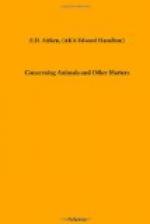The ears of dogs open up another vista for the questioning philosopher. Their day is past, too, and man may cut them short to match his own, but the dog grows them longer than before. When he first took service with man, and grew careless and lazy, the muscles got slack and the ears dropped, which is in accordance with Nature. Then, instead of being allowed to wither away, they have been handed over to the milliner and shaped and trimmed in harmony with the “style” of each breed of dogs. How it has been done is one of those mysteries which will not open to the iron keys of Darwin, But there it is for those to see who have eyes.
[Illustration: THE CURLS OF A MOTHER’S DARLING.]
The ears of the little dogs bred for ladies’ laps are the curls of a mother’s darling; the pendant love-locks of the old, old maid who, despite of changeful fashions, clings to those memorials of the pensive beauty of her youth, are repeated in solemn mimicry by the dachshund trotting at her heels; but the sensible fur cap of the dignified Newfoundland reminds us of the cold regions from which his forefathers came. Some kinds of terriers still have their ears starched up to look perky, and I have occasionally seen a dog with one ear up and the other down as if straining after the elusive idea expressed in the Baden-Powell hat. All which shows that “one touch of nature makes the whole world kin.”
VI
TOMMY
THE STORY OF AN OWL
Among the many and various strangers within my gates who have helped to enliven the days of my exile, Tommy was one towards whom I still feel a certain sense of obligation because he taught me for the first time what an owl is. For Tommy was an owl. From any dictionary you may ascertain that an owl is a nocturnal, carnivorous bird, of a short, stout form, with downy feathers and a large head; and if that does not satisfy you, there is no lack of books which will furnish fuller and more precise descriptions.
But descriptions cannot impart acquaintance. I had sought acquaintance and had gained some knowledge such as books cannot supply, not only of owls in general, but of that particular species of owls to which Tommy belonged, who, in the heraldry of ornithology, was Carine brahma, an Indian spotted owlet. This branch of the ancient family of owls has always been eccentric. It does not mope and to the moon complain. It flouts the moon and the sun and everyone who passes by, showing its round face at its door and even coming out, at odd times of the day, to stare and bob and play the clown. It does not cry “Tuwhoo, Tuwhoo,” as the poets would have it, but laughs, jabbers, squeaks and chants clamorous duets with its spouse.
All this I knew. I had also gathered from his public appearances that a spotted owlet is happy in his domestic life and that he is fond of fat white ants, for, when their winged swarms were flying, I had seen him making short flights from his perch in a tree and catching them with his feet; and I believed that he fed in secret on mice and lizards. But all that did not amount to understanding an owl, as I discovered when Tommy became a member of our chummery.




